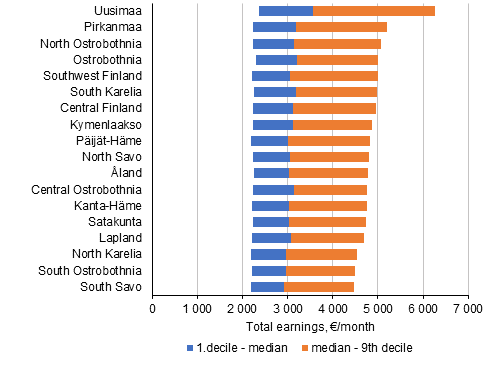Published: 11 March 2022
Managers’ wages and salaries vary most in the private sector
According to Statistics Finland’s Structure of Earnings statistics, the median for total earnings of full-time wage and salary earners was EUR 3,228 per month in 2020. The median pay of wage and salary earners in manager occupations was EUR 7,200 in the private sector, EUR 6,995 in the central government sector and EUR 5,176 in the local government sector. The dispersion of managers' salaries was biggest in the private sector, where the lowest salaries (1st decile) were EUR 4,279 and the highest salaries (9th decile) were EUR 11,890 per month. Among private sector managers the highest earning decile earned at least 2.8 times more than the lowest earning decile. The corresponding pay differential was 1.8 in the central government sector and 2.3 in the local government sector.
Distribution of total earnings of full-time wage and salary earners in manager occupations by sector in 2020

For the final release of the Structure of Earnings statistics for 2020, data were produced on previously missing salaries of private sector managers. Especially data on the occupational group of managing directors and chief executives (category 112) are missing from the previously published Structure of Earnings statistics. Due to this addition, managers' earnings can be better compared between different sectors and the statistics give a better picture than before of the salaries of enterprises' top management. Total earnings described in the statistics do not include one-off items, such as performance-based bonuses, which in the private sector in particular can form a significant part of total remuneration for managers.
Wages and salaries of enterprises’ top management grow by enterprise size
Measured by the number of wage and salary earners, the total earnings of managing directors and chief executives were, on average, the higher the larger the enterprise in which the manager was working. In enterprises with under 100 wage and salary earners, the median earnings of top management were EUR 9,500, while in enterprises with over 250 wage and salary earners the earnings were EUR 13,871. The biggest enterprises also had the largest dispersion in salaries. In enterprises with over 250 wage and salary earners, the highest paid decile of managing directors and chief executives earned at least 4.2 times as much as the lowest paid decile, while in enterprises with under 100 wage and salary earners the corresponding figure was 3.0 and in enterprises with 100 to 249 wage and salary earners 2.9.
Median for total earnings in occupational group 112 (managing directors and chief executives) in the private sector by the enterprise’s number of wage and salary earners in 2020

Highest pay and largest variation in pay in Uusimaa
Of the regions, median earnings were highest in Uusimaa, EUR 3,564. Median earnings were lowest in South Savo, EUR 2,919. The earnings of the highest earning decile in Uusimaa were clearly higher than in other regions. The highest earning decile earned EUR 6,254 or more in Uusimaa while in the other regions the earnings of the highest decile were EUR 4,886 or more. The earnings of the lowest earning decile in Uusimaa do not differ as much from the corresponding earnings level in other regions. In Uusimaa, 10 per cent of full-time wage and salary earners earned EUR 2,357 or less, while in the rest of the country the lowest decile earned EUR 2,226 or less.
Distribution of monthly total earnings of full-time wage and salary earners: 1st and 9th deciles and median by region in 2020.

Differences in average earnings and dispersion of earnings between regions are partly caused by differences in the structures of wage and salary earners between regions. More people work in manager and professional occupations in Uusimaa than in other regions. In Uusimaa, around five per cent of wage and salary earners worked in manager occupations and over 30 per cent in professional occupations. In other regions, the corresponding proportions were around 3 and 23 per cent. In these occupational groups the earnings level was on average higher than in other occupations.
The data in the release derive from Statistics Finland's Structure of Earnings statistics. The Structure of Earnings statistics for 2020 provide data on the earnings of around 1.4 million full-time wage and salary earners and altogether 1.7 million full-time and part-time wage and salary earners. The Structure of Earnings statistics describe all wage and salary earners for the public sector and those working in enterprises with more than five employees for the private sector.
The earnings data released in the statistics are total earnings. Apart from earnings for regular working hours, total earnings also include pay for any possible overtime and working hour supplements, premium pays, supplement for location and adverse working conditions, supplements based on duties, professional skills and years of service, performance-based pay components, compensation for standby and on-call work and benefits in kind, but not one-off pay items, such as performance-based bonuses. Total earnings are in gross, so taxes or other payments have not been subtracted from them.
Source: Structure of Earnings 2020, Statistics Finland
Inquiries: Matti Lahdenmäki 029 551 3690, Olli Ruuska 029 551 3274, palkkarakenne@stat.fi
Head of Department in charge: Hannele Orjala
Publication in pdf-format (217.1 kB)
- Tables
-
Tables in databases
Pick the data you need into tables, view the data as graphs, or download the data for your use.
Appendix tables
Updated 11.3.2022
Official Statistics of Finland (OSF):
Structure of Earnings [e-publication].
ISSN=1799-0092. 2020. Helsinki: Statistics Finland [referred: 29.12.2025].
Access method: http://stat.fi/til/pra/2020/pra_2020_2022-03-11_tie_001_en.html

